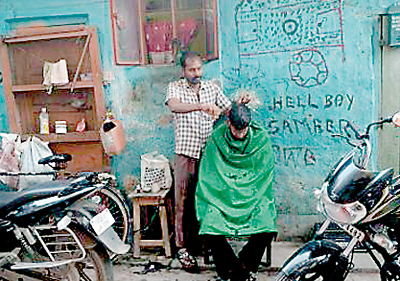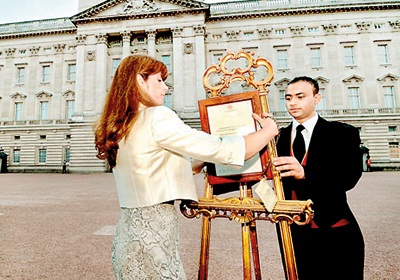Sunday Times 2
Badar Azim: Does the British Queen’s Indian ex-footman live in a slum?
Recently, like many other journalists in Calcutta, I was trying to find the Queen’s former footman, Badar Azim, who returned to India when his UK visa expired. British papers had written about his journey to Buckingham Palace from the “slums of Calcutta”… but this did not go down well with his family.

A streetside barner tends to a customer near the same residential complex where Badar Azim resides in Kolkata (AFP)
When I and a few other journalists knocked on the door of the house where Badar lived, his uncle opened it. Among the throng were a few of us who worked for British-based media organisations. He stared at us while he asked why foreign newspapers wrote lies about his nephew.
And he finished by saying: “They think that all of we Indians live in slums.” Some of the local journalists nodded their heads in agreement. Outside Badar’s house I met a friend of mine who works for a local news agency. She had a big smile on her face as she said, “You slumming it today?”
Before I could reply, she added: “How do you define what a slum is… I mean how do you guys know which area is a slum and which area isn’t?” It was a good question. Answering with more confidence than I really felt I said: “You don’t seem to know yourself – so to avoid any arguments about this why don’t we Google it.”
Before she could respond, I was typing away on my phone. Within seconds I had a definition from that most trusted of sources – the Oxford English Dictionary. I read it aloud: “A squalid and overcrowded urban area inhabited by very poor people.” We all then looked up at the building that Badar lived in. He and his two brothers, his mum and dad, and maybe a few more relatives, lived on the top floor. From the outside the structure looked shabby and the building which must once have been white was now a dirty grey colour.
There were open sewers outside it and the area was full of people – many of them children, who probably should have been at school.
There was silence for what seemed like a minute or more. Then one of Badar’s neighbours, Ghulam Mohammed, who had been listening to the conversation announced: “This cannot be a slum – because decent people live here.”

Badar Azim (right) and the Queen's press secretary Ailsa Anderson on Monday place on an easel in the forecourt of Buckingham Palace the notification to announce the birth of the baby to Prince William and Kate (AFP)
He then told me he had a proper job in an office – so how could he live in a slum? “I have a television and a motorbike, sir. Do slum-dwellers have these sorts of things?” he asked. This is not the first time that people in India have been upset with the use of the “S” word. Danny Boyle’s film Slumdog Millionaire may have won a host of Oscars but there were protests about its title across the world’s largest democracy.
I remember walking around one of Mumbai’s largest so-called slums and seeing posters that said “I am not a slumdog but the future of India.” In a way, this anger has grown as India’s economy has grown. India’s new middle class wants the world to look at their success, not the poverty that still exists in many parts of this country – something which, at times, they seem to ignore.
A friend of mine recently told me, “The problem with you foreigners is that you still think we are a land of snake-charmers and beggars.” When I pointed out that it was the United Nations, not journalists, who said that 50% of Mumbai’s population live in slums, he just shrugged his shoulders and said, “They are foreigners as well.”
Recently I had to visit one of the poorest parts of Calcutta when an 11-year-old girl was burned to death after resisting attempts to rape her. Locals took me to the field where she had died. We walked through large puddles of sewage water and past lots of small houses that looked like they were about to collapse and were crowded with families.
There were no toilets – people had to get their water from a dirty-looking well, and what little electricity there was would come and go. At one stage I asked one of the locals who had tried to save the girl whether it bothered him that people call this area a baasti, a slum.
“Only the rich have time for such debates,” he replied. “Nobody would want want to live here but we have no choice – whether you call it a slum or not makes no difference to us as it is not going to change our lives.”
(Courtesy BBC)
Follow @timesonlinelk
comments powered by Disqus

